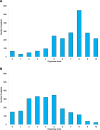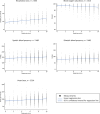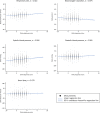Patient experience of severe acute dyspnoea and relief during treatment in ambulances: a prospective observational study
- PMID: 32245510
- PMCID: PMC7119173
- DOI: 10.1186/s13049-020-0715-2
Patient experience of severe acute dyspnoea and relief during treatment in ambulances: a prospective observational study
Abstract
Background: Acute dyspnoea is common among ambulance patients, but little is known of the patients' experience of symptom. We aimed to investigate ambulance patients initial perceived intensity of acute dyspnoea, and whether they experienced relief during prehospital treatment. Furthermore, to investigate the validity and feasibility of using a subjective dyspnoea score in the ambulance, and its association with objectively measured vital signs.
Methods: We performed a prospective observational study in the North Denmark Region from 1. July 2017 to 30. March 2019. We studied patients over the age of 18 to whom an ambulance was dispatched. Patients with acute dyspnoea assessed either at the emergency call or by ambulance professionals on scene were included. Patients were asked to assess dyspnoea on a 0 to 10 verbal numeric rating scale at the primary contact with the ambulance personnel and immediately before release at the scene or arrival at the hospital. Patients received usual prehospital medical treatment. We used visual inspection and Wilcoxon matched-pairs signed-ranks test, to assess dyspnoea scores and change hereof. Scatterplots and linear regression analyses were used to assess associations between the dyspnoea score and vital signs.
Results: We included 3199 patients with at least one dyspnoea score. Of these, 2219 (69%) had two registered dyspnoea scores. The initial median dyspnoea score for all patients was median 8 (interquartile range 6-10). In 1676 (76%) of patients with two scores, the first score decreased from 8 (6-9) to 4 (2-5) during prehospital treatment. The score was unchanged for 370 (17%) and increased for 51 (2%) patients. Higher respiratory rate, blood pressure, and heart rate was seen with higher dyspnoea scores whereas blood oxygen saturation lowered.
Conclusions: We found that acute dyspnoea scored by ambulance patients, was high on a verbal numerical rating scale but decreased before arrival at hospital, suggesting relief of symptoms. The acute dyspnoea score was statistically associated with vital signs, but of limited clinical relevance; this stresses the importance of patients' experience of symptoms. To this end, the dyspnoea scale appears feasible in the prehospital setting.
Keywords: Acute dyspnoea; Ambulance; Blood oxygen saturation; Blood pressure; Dyspnoea score; Heart rate; Prehospital; Respiratory rate; Verbal numerical rating scale; Vital signs.
Conflict of interest statement
The authors declare that they have no competing interests.
Figures




References
Publication types
MeSH terms
LinkOut - more resources
Full Text Sources
Medical
Miscellaneous

